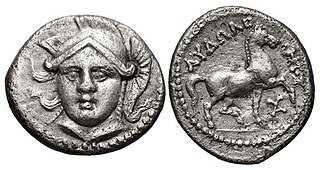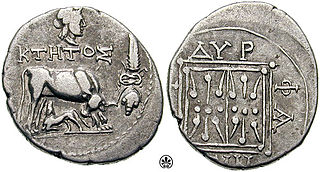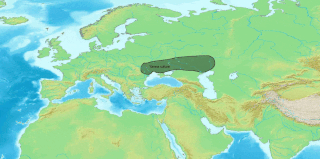
Leon of Paionia (Greek: Λέων) (278 BC – 250 BC) was an ancient Paeonian [1] king, the father of Dropion.

Leon of Paionia (Greek: Λέων) (278 BC – 250 BC) was an ancient Paeonian [1] king, the father of Dropion.
Agis or AGIS may refer to:

In antiquity, Paeonia or Paionia was the land and kingdom of the Paeonians or Paionians.

Bylazora or Vilazora was a Paeonian city from the period of early classic antiquity. It is located near the village of Knezhje, which is part of the municipality of Sveti Nikole in North Macedonia.

Megabazus, son of Megabates, was a highly regarded Persian general under Darius, to whom he was a first-degree cousin. Most of the information about Megabazus comes from The Histories by Herodotus.

Polykastro is a town and a former municipality in Kilkis regional unit of Central Macedonia, Greece. Since the 2011 local government reform it is part of the municipality Paionia, of which it is a municipal unit, and the seat. The municipal unit has an area of 312.717 km2, the municipal unit 45.775 km2. The municipal unit of Polykastro has 12,000 inhabitants, and includes Polykastro and 23 villages. It is built near the Axios River, on the road and railway from Thessaloniki to Belgrade. It was formerly known as Karasuli (Turkish), Mavrosuli or Rugunovec.

Ariston was a member of the Paionian royal house, possibly brother of King Patraus and father of the later king, Audoleon. His service with Alexander the Great, like that of the Thracian Sitalces II and others, helped to ensure the loyalty of his nation to Macedon in the King's absence. He was the commander of the unit of Paionian cavalry. Initially only one squadron strong, the Paionians received 500 reinforcements in Egypt and a further 600 at Susa.
Longarus was an Illyrian king of the Dardanian Kingdom. Longarus was at war with various Macedonian kings and managed to conquer at different times part of Macedonia. Longarus was an ally of the Paeonian State and liberated the Paeonians in order to open the routes towards Macedonia. Longarus' influence grew and many other Illyrians from the Ardiaean Kingdom joined him.
Darrhon or Darron was a Paeonian god of healing, whose cult was adopted by the ancient Macedonians, as mentioned by Hesychius as a Macedonian Daemon and attested hapax in one inscription of Pella c. 200 – 150 BC.
Ἀμφίπολις Δάρρωνι εὐξαμένη ἐπηκόωι. Amphipolis Darrhoni euxamene epekooi. Amphipolis who prayed to benevolent Darrhon.

Agis was founder and king of the Paeonian kingdom. A contemporary of Philip II of Macedon, Agis was a pretender to the Macedonian throne in a time of instability. His successor was Lycceius.

Lyppeius was king of the ancient kingdom of Paeonia from 359/8 until his death around 335 BC. He succeeded the first known Paeonian king, Agis, under unknown circumstances and may have been his son, but this is only speculation.

Patraus was king of the ancient kingdom of Paeonia from around 335 until his death in 315 BC. Patraus' relationship with the previous Paeonian king, Lyppeius, is unknown, as are the circumstances surrounding his ascension. Aside from the silver coinage struck in his name, we know nothing for certain about the events of Patraus' reign.

Audoleon was king of the ancient kingdom of Paeonia from 315 until his death in 285 or 284 BC. He succeeded his father, Patraus, under unknown circumstances.

Dropion was an ancient Paeonian king, the son of Leon of Paionia.

Illyrian coinage which began in the 6th century BC continued up to the 1st century of Roman rule. It was the southern Illyrians who minted the first coins followed by the northern Illyrian during the Roman era. Illyrian coins have also been found in other areas apart from Illyria, such ancient Macedonia, Italy, Greece, Asia Minor and Egypt.
Grabus was an Illyrian king who reigned in southern Illyria in the 4th century BC.
The Illyrians were a group of Indo-European speaking peoples, who inhabited the western Balkan Peninsula in ancient times. They constituted one of the three main Paleo-Balkan populations, along with the Thracians and Greeks.
Serraepolis or Serraipolis was a town of ancient Cilicia in Asia Minor on the lower course of river Pyramos. It was also known under the names Serretillis (Σερρέτιλλις), Ser(r)opolis, Serrai kome and Siris, as well as Kassipolis by Pliny.

Paeonians were an ancient Indo-European people that dwelt in Paeonia. Paeonia was an old country whose location was to the north of Ancient Macedonia, to the south of Dardania, to the west of Thrace and to the east of Illyria, most of their land was in the Axios river basin, roughly in what is today North Macedonia.